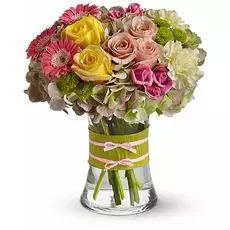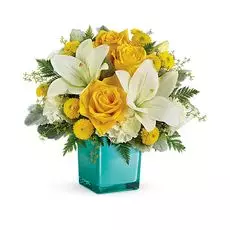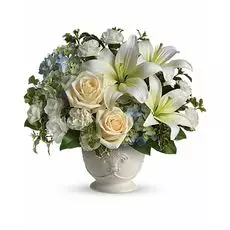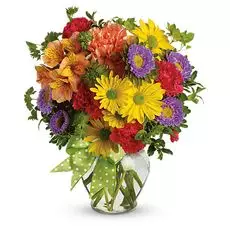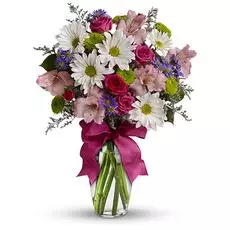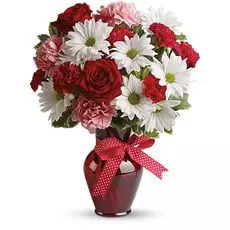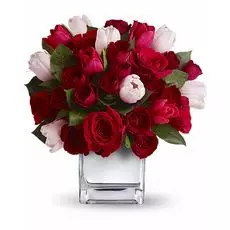Explore How Birth Month Flowers Connect History, Symbolism, and Personal Stories
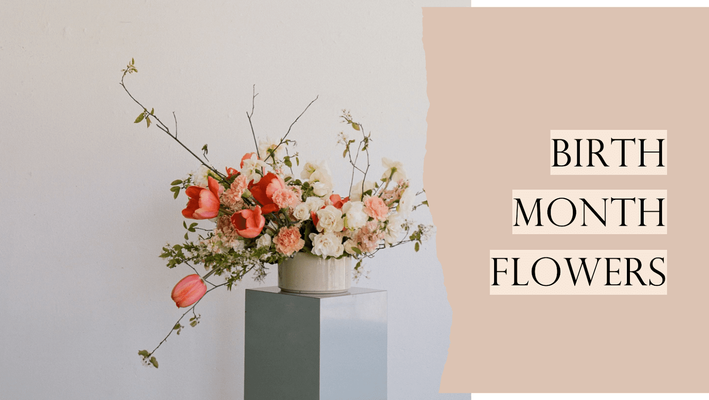
Flowers are universal messengers of emotion. Throughout history, in every corner of the world, these natural wonders have been intertwined with human experiences, adding color, scent, and profound symbolism to our most significant moments. As embodiments of nature's artistry, flowers speak a language of their own, capable of conveying messages that often words can't fully capture. Among these symbolic communications is the tradition of birth month flowers - a unique floral emblem for each month that carries special significance.
Birth month flowers are a celebration of life, personifying the distinct character of each month and those born within it. Just as individuals have their own unique qualities and traits, so too do these flowers, each with its unique color, form, fragrance, and meaning. They serve as nature's birthday gifts, flowering in their respective months, adding vibrancy to the world around us, and bringing unique symbolism to the lives of those who call that month their own.
This tradition of assigning flowers to specific months has ancient roots, tracing back to the time when people closely watched the cycles of nature and saw in them a mirror of human life. Each flower's bloom became associated with the month it most commonly appeared, linking it forever to that time. Over time, this tradition evolved into the list of birth month flowers we know and recognize today.
In this comprehensive guide, we'll journey through each month of the year, exploring the beauty and symbolism of each birth flower. We'll delve into the cultural and historical significance of these blossoms and reveal the unique traits they symbolize. So whether you're seeking a personalized gift for a loved one's birthday or simply curious about the flower that represents your own birth month, this guide will offer a vibrant exploration of these natural emblems and their deep-rooted meanings.
This journey through the calendar year, filled with rich symbolism and botanical beauty, provides a delightful way to commemorate each individual's unique place in the cycle of life. After all, a birth month flower is more than just a botanical phenomenon; it's a reflection of our individual journeys, brimming with personal significance and universal connection.
The Significance of Birth Month Flowers
Flowers have had symbolic meanings in nearly every society throughout history, and that remains true today. The tradition of associating specific flowers with certain months dates back to ancient times, with these birth month flowers often carrying particular connotations or messages that were understood by people from those cultures. The significance of these birth month flowers continues to resonate today, bringing added depth and symbolism to our flower gifting practices.
Each birth month flower encapsulates the spirit of a specific month and is believed to hold certain properties or characteristics of individuals born in that period. For instance, February’s Violet symbolizes modesty, humility, and faithfulness, perhaps embodying the qualities we often associate with individuals born in this month. Meanwhile, April's Daisy, representing purity and new beginnings, may resonate deeply with people born in a month known for renewal and the spring's fresh start.
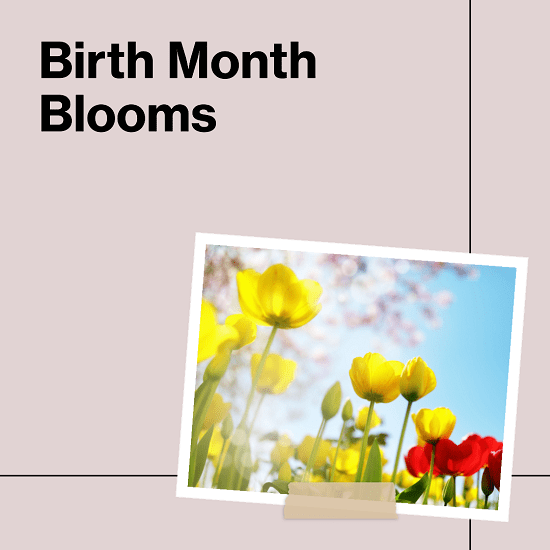
Moreover, birth month flowers can serve as a mirror, reflecting the changing seasons of the year. The delicate Carnation and the resilient Snowdrop bloom amidst the chill of January, symbolizing the perseverance of life amidst harsh conditions. Contrastingly, the radiant Sunflower and bold Gladiolus of August celebrate the peak of summer, embodying warmth, strength, and the grandeur of life in full bloom.
Additionally, birth month flowers also give us a connection to our past. These flower associations are steeped in history, often linked with ancient myths, folklore, and cultural traditions. When we gift someone their birth month flower, we are, in a way, connecting them to a rich tapestry of tales and traditions that spans centuries.
Furthermore, understanding the meaning behind these flowers adds a layer of personalization and intention to our gifts. When you choose to gift someone their birth month flower, it says you've put thought and consideration into the gift, elevating it from a simple bouquet to a personalized message of care and recognition. It shows that you acknowledge their individuality and want to celebrate it, making the gift all the more special and appreciated.
Comprehensive Breakdown of Birth Month Flowers
January - The Carnation

Bold yet delicate, carnations are the birth flowers for January1. These blossoms, also known as Sweet William or gillyflowers, are scientifically named Dianthus caryophyllus, which translates to "flower of the gods". The name carnation may come from "coronation" because they were used in Greek ceremonial crowns, or from the Latin carnis (flesh), referring to the flower's original pink hue.
Carnations have a rich history, with cultivation dating back over 2,000 years to ancient Greece and Rome, where they were used in art, ceremonies, and as medicinal remedies2. In Christian lore, red carnations are said to have sprung from the Virgin Mary's tears as she watched Jesus carry the cross, linking them to motherly love.
These popular flowers come in a wide array of colors, each with its unique symbolism:
Red: Represents love, deep affection, and admiration. Light red carnations symbolize admiration, while dark red denotes deep, passionate love.
Pink Carnations
Symbolizes gratitude, motherly love, and deep feelings of thankfulness
White Carnations
Represents purity, innocence, and devotion - often seen in wedding ceremonies
Purple Carnations
Expresses capriciousness and apology - commonly used in French funeral arrangements
Yellow Carnations
Conveys disappointment, rejection, and feelings of sorrow
Carnations are versatile flowers, used in bouquets, corsages, and various floral arrangements. They are also edible and have been used to flavor wines. Carnations have been used to study genetics and flower pigmentation, even leading to genetically modified varieties with colors not naturally found in carnations.
In Our Expert Opinion
We believe carnations stand out as January’s birth flower because they uniquely capture the fresh hope and resilience that often marks the start of a new year. Their timeless appeal—dating back over two millennia—remains remarkably relevant, thanks to wide-ranging colors that speak to every sentiment. Whether you choose soft pink blooms symbolizing motherly love or bold red carnations for deeper affection, each shade feels purposeful yet never overwhelming.
Beyond their symbolism, carnations are prized for their sturdy nature, making them a practical choice for January’s sometimes chilly, unpredictable weather. Their layered petals and light, pleasing fragrance add an understated elegance to bouquets and corsages, without stealing the spotlight from other complementary flowers. In our experience, those celebrating a January birthday gravitate to carnations because they’re both budget-friendly and versatile—equally suited for a grand bouquet or a simple vase arrangement on the kitchen table. Ultimately, this “flower of the gods” starts the new year with an optimistic flourish, marrying classic roots with an enduring ability to charm.
February - The Violet
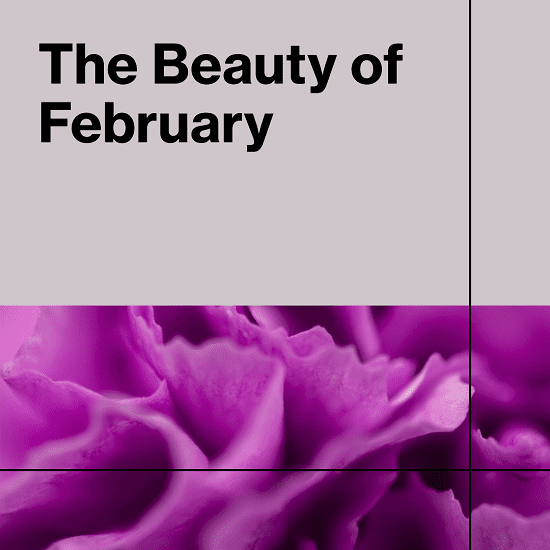
For February, we have the humble violet, symbolizing modesty, faithfulness, and humility.
These charming flowers belong to the Viola genus, a large family of flowering plants with over 500 species. The name "violet" has origins in the Greek word "ion," referring to the flower, linked to the mythological story of Io, who Zeus turned into a heifer and fed violets. Violets have a long history, appreciated by ancient Greeks and Romans for medicinal and culinary uses, and adorning gardens and wreaths. They were also used in perfumes and wines. In Victorian times, violets symbolized faithfulness, and giving a violet implied "I'll always be true". While commonly known for their blue-purple hues, violets can also be found in an array of other shades, including yellow, white, and cream. This color diversity contributes to the nuanced symbolism associated with violets:
Purple
Represents royalty, dignity, and admiration
Blue
Symbolizes faithfulness, love, and truth
White
Signifies purity, innocence, and new beginnings
Yellow
Associated with optimism, joy, and happiness
Violets are versatile flowers often used in perfumes, candies, and teas. Candied violets are a popular confection in some regions, while violet syrup adds a unique flavor to beverages. Medicinally, violets have been used for their anti-inflammatory and antioxidant properties. Whether as a charming garden flower or a thoughtful gift, the violet's rich history and varied symbolism make it a meaningful emblem for those born in February.
In Our Expert Opinion
We believe violets enchant people born in February because they represent more than just beauty; they carry timeless values like faithfulness, modesty, and devotion. Their delicate petals and subtle fragrance evoke a sense of quiet charm—perfect for a month that heralds the end of winter and the gentle promise of spring. Violets’ rich mythological roots and varied color palette (from regal purples to uplifting yellows) also allow them to speak to personal styles and sentiments. Whether used in confectionery, perfumes, or as vibrant garden accents, violets continue a legacy that blends myth, medicinal lore, and poetic symbolism—making them a meaningful emblem for those celebrating February birthdays.

March - The Daffodil
Embodying rebirth, hope, and the essence of spring, daffodils are the birth flowers for March. These cheerful, trumpet-shaped blossoms, scientifically known as Narcissus, are a welcome sight after winter. The name Narcissus comes from Greek mythology, where a beautiful youth named Narcissus was so captivated by his reflection that he drowned, and a narcissus flower sprang up in his place.
Daffodils have been cultivated for centuries and are native to Europe, North Africa, and West Asia. They hold varying symbolism across cultures:
China
Daffodils symbolize good luck and prosperity, particularly during the Chinese New Year
Wales
National flower symbolizing faithfulness. Traditionally worn on St. David's Day (March 1)
General Symbolism
Represents hope, rebirth, new beginnings, and resilience - heralding spring after winter
Daffodils come in various shapes and colors, including yellow, white, orange, and pink. Different types of daffodils include trumpet daffodils, large-cupped daffodils, small-cupped daffodils, double daffodils, and triandrus daffodils. The bright yellow color is most commonly associated with daffodils and symbolizes joy, happiness, and optimism. They are often given as gifts to celebrate new beginnings or to offer encouragement during challenging times.
Daffodils are relatively easy to grow, making them a popular choice for gardens and landscapes. They naturalize well, meaning they can spread and multiply over time, creating a beautiful display of spring color year after year. Their resilience and vibrant appearance make them a perfect symbol for March, representing the hope and renewal that comes with the changing season.
In Our Expert Opinion
We believe daffodils enchant March-born individuals because their bright petals and lively trumpet shapes exuberantly declare winter’s end—bringing hope and renewal in a single bloom. They’re a visible promise of warmer days ahead, a sentiment that aligns beautifully with celebrating a March birthday. Additionally, daffodils possess a fascinating blend of cultural significance: from symbolizing prosperity in China to serving as Wales’ national flower of faithfulness. That rich heritage, coupled with their easy-to-grow nature and ability to naturalize in gardens, makes daffodils a true testament to resilience and optimism—characteristics that perfectly reflect the early spring season.
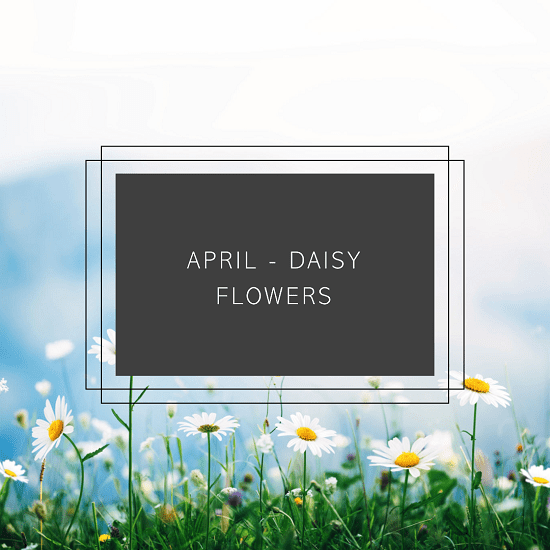
April - The Daisy
April welcomes the beautiful daisy, the symbol of purity, true love, and new beginnings. The name "daisy" is thought to be a derivation of "day's eye," because the flower opens its petals at dawn and closes them at dusk.
Daisies belong to the Asteraceae family, one of the largest plant families, and have been admired for centuries. They have a long history, with evidence suggesting they were used medicinally by the ancient Egyptians. In Victorian times, daisies symbolized innocence and were often exchanged as tokens of affection.
Known for their bright white petals and cheerful yellow center, daisies also come in various colors, including pink, red, and purple. Different types of daisies include the common daisy (Bellis perennis), Shasta daisy, and gerbera daisy. The symbolism of daisies can vary slightly depending on the color:
White
Signifies purity, innocence, and new beginnings
Pink
Represents love, affection, and gratitude
Red
Symbolizes love, passion, and romantic feelings
Daisies are often associated with children and are used in games like "he loves me, he loves me not," where petals are plucked to predict romantic outcomes. They are also edible, and their petals can be added to salads or used as a garnish. Their simple beauty and positive symbolism make them a popular choice for bouquets, gardens, and as a representation of the freshness of spring.
In Our Expert Opinion
We think daisies align beautifully with the spirit of April because their bright, open faces capture the feeling of fresh starts and optimism that springtime brings. Their name—“day’s eye”—perfectly reflects the way these flowers greet each new day, making them an inspiring choice for anyone embarking on a new year of life.
Beyond their sunny disposition, daisies have a fascinating historical connection to innocence and true love, which resonates with the sense of renewal that April evokes. Whether you stick to classic white or opt for vibrant pink or red varieties, daisies have a knack for reminding us of simpler joys and playful traditions—like the timeless “he loves me, he loves me not” petal-plucking game. In our experience, that blend of purity, cheer, and sweet nostalgia is precisely why daisy bouquets remain such a popular pick for April birthdays.

May - Lily of the Valley
May is marked by the enchanting Lily of the Valley. Scientifically known as Convallaria majalis, these delicate, bell-shaped flowers symbolize sweetness, humility, and the return of happiness.
Lily of the Valley has a rich history steeped in folklore and religious symbolism. Its name, Convallaria, is derived from the Latin word convallis, meaning "valley," referring to its preferred growing habitat. Majalis means "belonging to May." In Christian legend, the flower is associated with the tears of the Virgin Mary at the foot of the cross, which turned into Lily of the Valley.
These fragrant flowers are often used in wedding bouquets, representing purity and good luck in marriage. In the language of flowers, Lily of the Valley conveys the message, "You've made my life complete."
Sweetness
Represents a kind and gentle nature
Humility
Signifies modesty and grace
Return of Happiness
Symbolizes hope and the restoration of joy after sorrow
Lily of the Valley is native to Europe and Asia and has naturalized in North America. The plant prefers shady locations and moist soil. It's important to note that Lily of the Valley is poisonous if ingested, so caution should be taken when growing it in gardens, especially around children and pets. Despite its toxicity, Lily of the Valley has been used in traditional medicine and perfumery for its fragrance. Its delicate beauty and powerful symbolism make it a beloved flower for those born in May.
In Our Expert Opinion
We think Lily of the Valley is perfect for May because its gentle, bell-shaped blossoms and sweet fragrance beautifully capture that sense of renewed joy that emerges in spring. It’s a flower steeped in graceful symbolism—from humility to hope—which aligns perfectly with the month’s theme of rebirth and new beginnings. Add in its storied past in weddings and folklore, and you have a bloom that’s not only visually charming, but also carries an extra layer of heartfelt meaning for those celebrating a May birthday.
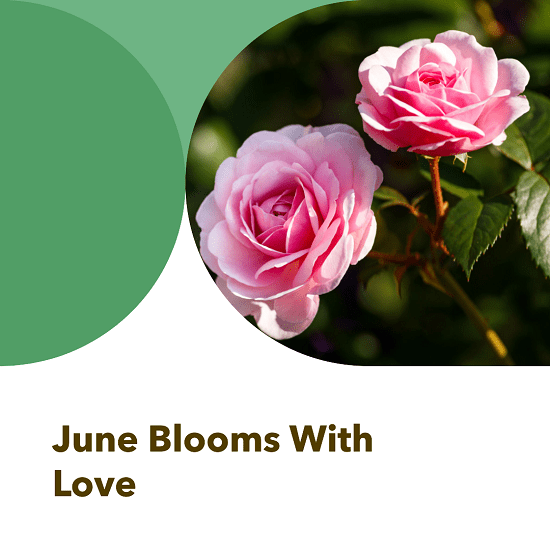
June - The Rose
Synonymous with love and passion, the rose is the birth flower for June. Roses belong to the Rosa genus, encompassing over 100 species of perennial shrubs. The rose has a long and celebrated history, dating back to ancient civilizations where they were cultivated for their beauty and fragrance. They were revered by the ancient Greeks and Romans, who associated them with goddesses of love like Aphrodite and Venus.
Roses come in a wide variety of colors, each with its unique meaning:
Red
Represents love, passion, and romance
White
Symbolizes purity, innocence, and spirituality
Pink
Signifies gratitude, appreciation, and admiration
Yellow
Represents friendship, caring, and joy
Orange
Symbolizes enthusiasm, desire, and excitement
Lavender
Signifies enchantment, wonder, and love at first sight
Beyond their symbolic meanings, roses have practical uses. Rose petals are used to make rose water, rose oil, and potpourri. Rosehips, the fruit of the rose plant, are rich in Vitamin C and are used to make jams, jellies, and teas.
The rose is also the national flower of England and the state flower of several U.S. states. Whether given as a romantic gesture or a token of friendship, the rose's beauty and fragrance make it a timeless and cherished flower.
In Our Expert Opinion
We believe roses perfectly capture June’s essence because they flourish during late spring and early summer, at a time when nature is in full, vibrant bloom—much like the passionate and expansive energy of the season. Not only do they appear in a dazzling range of colours, each with its own layered symbolism, but their fragrance and delicate petals also evoke a classic sense of romance that June birthdays often crave.
Beyond their beauty, roses connect us to a rich heritage spanning from ancient civilizations to modern traditions—whether it’s their association with Aphrodite and Venus or their frequent use in perfumes and culinary delights. Add to that their symbolic versatility (red for love, yellow for friendship, pink for gratitude, etc.), and you’ll see why roses make an effortlessly meaningful gift for anyone born in June. Their timeless appeal, combined with a seasonal flourish, ensures they remain a perennial favorite for celebrating this sun-kissed month.
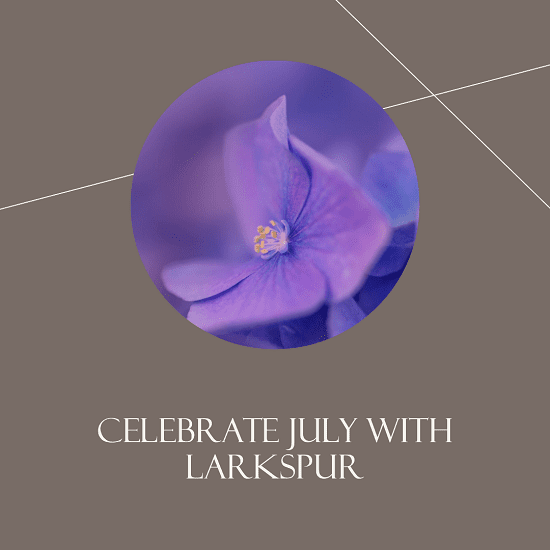
July - The Larkspur
July brings the larkspur, also known as delphinium, recognized for its tall spikes and bright, beautiful petals. The name "larkspur" comes from the Greek word delphis, meaning "dolphin," referring to the shape of the flower's nectary.
Larkspurs have a history rooted in ancient Greece, where they were used for medicinal purposes. In the language of flowers, larkspurs carry various meanings depending on their color:
Pink
Symbolizes fickleness or contradiction
White
Represents a happy-go-lucky attitude
Purple
Signifies first love
Generally, larkspurs symbolize positivity, dignity, grace, and levity. These tall, elegant flowers add a touch of drama to any garden or floral arrangement. Larkspurs are popular in cottage gardens and are often used as cut flowers.
They come in various colors, including blue, purple, pink, and white, and are relatively easy to grow, preferring full sun and well-drained soil. Their striking appearance and positive symbolism make them a meaningful choice for those born in July.
In Our Expert Opinion
We believe larkspurs capture July’s spirit by combining a vibrant, summery appearance with an air of cheerful elegance. Their tall spikes and variety of colors reflect the season’s energetic mood—bold yet lighthearted—making them ideal for celebrating midsummer birthdays. Plus, with symbolic meanings ranging from positivity and dignity to that first blush of love, larkspurs add both visual drama and emotional resonance to any bouquet or garden. Their easy-to-grow nature also aligns nicely with July’s laid-back warmth, allowing them to thrive in bright sun and well-drained soil without excessive fuss.
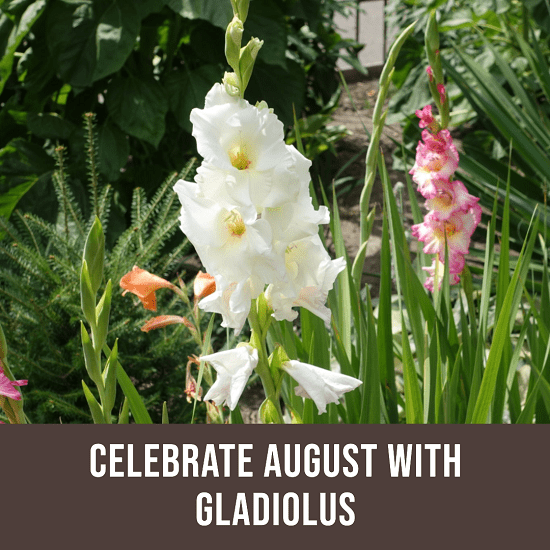
August - The Gladiolus
Representing strength, moral integrity, infatuation, sincerity, faithfulness, and remembrance, the sword-shaped gladiolus is the birth flower for August. The name "gladiolus" comes from the Latin word gladius, meaning "sword," referring to the shape of its leaves. It is also known as the "sword lily."
Gladiolus has deep cultural roots in ancient history, especially in the Roman Empire, where gladiators reportedly wore gladiolus corms around their necks for protection and victory in battle. The flowers were also used to honor heroes and celebrate victories. The gladiolus symbolizes the strength and resilience of a warrior.
In the Victorian era, gifting gladioli conveyed messages of love, infatuation, and moral integrity. The flower was believed to "pierce the heart with its beauty," symbolizing deep admiration. Gladiolus is also the national flower of the British Virgin Islands and the traditional flower for a 40th-anniversary gift.
Gladioli come in a wide array of colors, each carrying its own symbolism:
Red
Symbolizes love, passion, and romance
Pink
Represents compassion, grace, femininity, maternal love, and non-romantic love
White
Signifies purity, innocence, spirituality, and sincerity—often used in weddings
Yellow
Represents friendship, joy, happiness, and well wishes
Purple
Symbolizes charm, grace, mystery, creativity, and a quest for wisdom
Orange
Represents enthusiasm, desire, and excitement
Green
Signifies growth and harmony
Blue
Represents calmness, serenity, and tranquility
Gladiolus plants are native to South Africa and were introduced to Europe in the 1700s via the Indian trade route. Hybridization began in the Netherlands in the early 1800s. There are over 260 species of gladiolus with more than 10,000 registered cultivars.
These tall plants can grow up to 4 feet or even 6 feet in optimal conditions, with flowers arranged in a compact column. The blooms open one after the other, creating a spectacular sight.
In Our Expert Opinion
We believe gladiolus perfectly captures August’s energy by combining both boldness and grace—much like the late-summer warmth that still holds a touch of lingering brightness. Known as the “sword lily,” these tall and striking blooms echo a sense of fortitude and resilience, reflecting the month’s transitional, high-spirited nature. With vibrant colours that symbolise everything from love and passion to integrity and friendship, gladiolus covers the emotional spectrum. For August birthdays, it’s the ideal floral emblem—one that celebrates strength, sincerity, and the warrior’s heart tucked beneath summer’s waning sun.
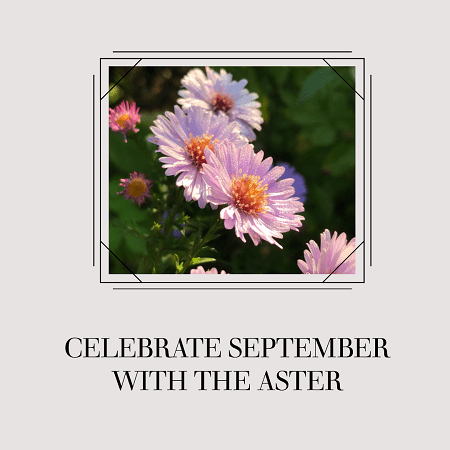
September - The Aster
Asters, the birth flowers of September, signify love, wisdom, and royalty. The name "aster" comes from the Greek word for "star," referring to the star-like shape of the flower head.
Asters have a rich history, having been used for medicinal purposes by the ancient Greeks and Romans. They were thought to ward off evil spirits and were often burned to purify sacred spaces. In Victorian times, asters symbolized love and patience.
With star-like blooms in a range of colors, including purple, pink, white, and blue, they add a dash of elegance to any floral arrangement. The symbolism of asters can vary slightly depending on the color:
Purple
Represents royalty, wisdom, and admiration
Pink
Symbolizes love, sensitivity, and affection
White
Signifies purity, innocence, and new beginnings
Asters are also known as Michaelmas daisies because they often bloom around Michaelmas (September 29th). They are popular in gardens and are relatively easy to grow, preferring full sun and well-drained soil. Their late-season blooms provide a valuable source of nectar for pollinators as other flowers begin to fade. Their beauty and symbolism make them a meaningful choice for those born in September.
In Our Expert Opinion
Few flowers align so naturally with September’s gentle shift into autumn as the starry aster. Beyond adding jewel-toned pops of purple, pink, or white to late-summer gardens, asters also carry a sense of thoughtful serenity—perfect for marking the end of one season and the start of another. They’ve been revered since ancient times, reflecting love, wisdom, and royalty in various cultures. Meanwhile, the fact that they bloom just as many other flowers fade makes them a graceful symbol of resilience and understated beauty. For anyone born in September, asters deliver a poetic blend of star-like shape, historical lore, and subtle charm that perfectly encapsulates this month’s quiet yet profound transition.
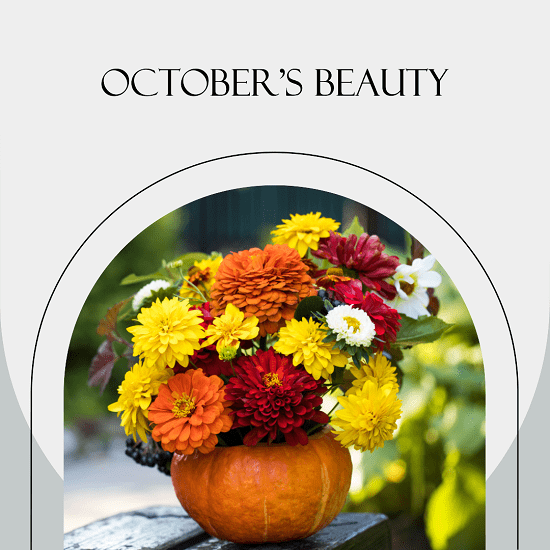
October - The Marigold
Vibrant marigolds are the birth flowers for October. The name "marigold" is believed to be derived from "Mary's Gold," referring to the Virgin Mary. Marigolds belong to the Calendula and Tagetes genera.
Marigolds have been used for centuries in various cultures for medicinal, culinary, and ornamental purposes:
- In ancient Aztec culture, marigolds were associated with the sun and were used in religious ceremonies.
- In India, marigolds are often used in garlands and decorations for weddings and religious festivals.
- The ancient Greeks used marigolds for various skin ailments.
Known for their rich, golden-orange hues, they also come in yellow, red, and bi-colored varieties. Marigolds symbolize creativity, passion, warmth, cheerfulness, and prosperity.
Marigolds are easy to grow and are often used in companion planting to deter pests in vegetable gardens. Calendula (pot marigold) petals are edible and can be added to salads or used to make tea. Marigold extracts are also used in cosmetics and skincare products for their anti-inflammatory and antioxidant properties.
Their vibrant colors and positive symbolism make them a popular choice for gardens and gifts.
In Our Expert Opinion
Marigolds bring a burst of sunshine to autumn, making them an energizing choice for October birthdays. Their fiery gold and orange petals naturally echo the color palette of changing leaves, capturing both the cozy warmth and underlying vibrancy of the season. Historically cherished by cultures from the Aztecs to Indian wedding traditions, marigolds carry a global heritage of passion, prosperity, and protective spirit. They’re also resilient enough to thrive in cool fall weather, offering an effortless blend of beauty and practicality. Altogether, this makes them a fitting emblem for anyone marking new milestones in October.
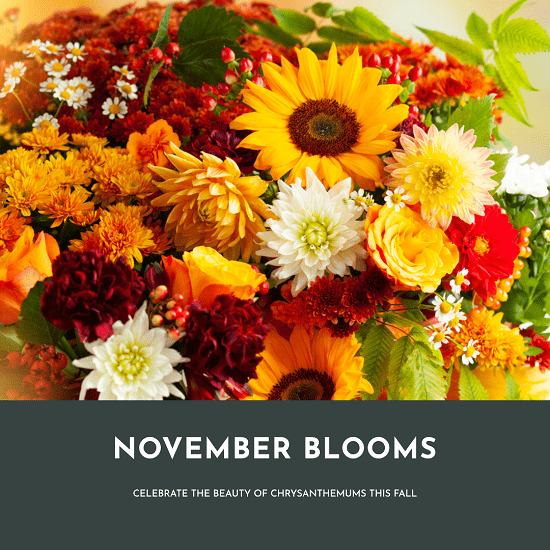
November - The Chrysanthemum
The November birth flower, the chrysanthemum, stands for loyalty, joy, and longevity. The name "chrysanthemum" comes from the Greek words "chrysos" (gold) and "anthemon" (flower), originally referring to the flower's golden color.
Chrysanthemums have a rich history, especially in Asian cultures:
- First cultivated in China as far back as the 15th century BC, they were considered one of the "Four Gentlemen" (along with the plum blossom, orchid, and bamboo) in Chinese art.
- Introduced to Japan in the 8th century AD, chrysanthemums became so beloved that they were adopted as the Imperial Seal of Japan.
The symbolism of chrysanthemums varies across cultures:
- China: Symbolizes longevity, good luck, and is often associated with funerals.
- Japan: Represents the sun, perfection, and power.
- Western Cultures: Generally symbolizes joy, loyalty, and compassion.
Chrysanthemums come in a wide variety of colors, each with its unique meaning:
Red
Represents love and passion
White
Symbolizes purity, innocence, and honesty
Yellow
Signifies joy, celebration, and optimism
Chrysanthemums are a common gift for a 13th wedding anniversary, wishing a couple a long and joyful life together. They are also popular in gardens and floral arrangements, offering a burst of color in the late autumn months. Their versatility and rich symbolism make them a meaningful choice for those born in November.
In Our Expert Opinion
Chrysanthemums, with their layers of lush petals and striking autumn hues, seem tailor-made for November’s cool, introspective vibe. They’re often the final burst of color before winter sets in, symbolizing endurance and quiet celebration—a sentiment that resonates perfectly with late-fall birthdays. Across different cultures, these “mums” carry powerful meanings, from good fortune and longevity in China to regal heritage in Japan. Their versatility in both appearance and symbolism means they can seamlessly transition between hearty porch displays and refined table centerpieces. For anyone born in November, chrysanthemums offer an elegant and spirited way to mark the month’s reflective yet hopeful character.
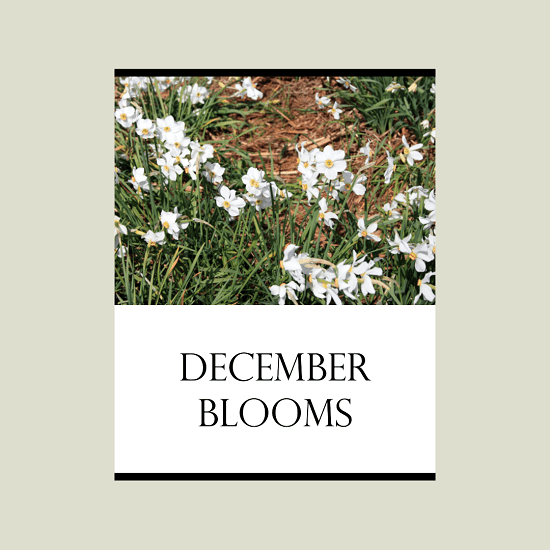
December - The Narcissus
Narcissus, with their bright petals, are December's birth flower. Symbolizing respect, faithfulness, and good wishes, these flowers add cheer to the winter months. The name "narcissus" comes from Greek mythology, where a vain youth named Narcissus became so obsessed with his reflection that he drowned and turned into the narcissus flower.
Narcissus flowers are native to Europe and the Mediterranean region. They have been cultivated for centuries and are popular for their beauty and fragrance.
The symbolism of narcissus flowers includes:
Respect
Signifying admiration and high regard
Faithfulness
Representing loyalty and commitment
Good Wishes
Conveying positive sentiments and blessings
Narcissus flowers come in a variety of shapes and colors, including white, yellow, orange, and pink. Some common types of narcissus include daffodils, paperwhites, and jonquils.
In some cultures, narcissus flowers are associated with the New Year and are given as gifts to bring good fortune. Their cheerful appearance and pleasant fragrance make them a popular choice for brightening up homes during the winter months.
In Our Expert Opinion
Narcissus flowers bring a bright and hopeful presence to December, a month often associated with shorter days and cooler weather. Their cheery petals feel like a gentle promise of renewal, aligning with the season’s reflective yet optimistic spirit. Beyond their pleasing appearance, narcissus blooms carry beautiful meanings of respect and faithfulness—a sentiment that resonates when the year winds down, and we focus on the commitments and relationships we value most. Plus, their fragrant scent adds a welcome burst of comfort in wintertime, making narcissus arrangements a thoughtful gift or décor accent for December birthdays and holiday festivities alike.
Spotlight on a Birth Month Flower: The Daffodil
Each of these birth month flowers has a rich history and cultural significance that is as fascinating as the flowers themselves. For instance, consider the Daffodil, the birth flower of March, emblematic of hope, rebirth, and the long-awaited spring. These vibrant yellow blooms are cherished worldwide for their unique beauty and symbolic importance.
At Lily's Florist, we delve into the fascinating world of these flowers, their history, and their cultural connotations. In our blog post, "The Daffodil - The March Birth Month Flower," we explore the story of the Daffodil in greater detail. From ancient Greek mythology to modern-day traditions, we unveil the journey of this beloved flower through the ages.
Adding a Personal Touch
Adding a personal touch to your gift can transform an already special moment into a truly unforgettable one. A birth month flower not only adds beauty to the gift but also speaks volumes about your thoughtfulness. This is why we recommend taking the time to learn about these flowers and their unique significance.
If you or your loved ones are born in March, or simply have an affinity for Daffodils, we encourage you to explore our blog post. It's an interesting read that uncovers the symbolic meaning, interesting trivia, and fun facts about this remarkable flower.
Gifting Made Special
From Roses in June to Marigolds in October, every birth month flower has a unique story to tell. As you learn about these flowers, you'll find yourself better equipped to select the perfect floral arrangement for the special people in your life. And by doing so, you elevate the simple act of gifting flowers into a heartfelt message of love and appreciation.
Gifting flowers that hold a special significance to the recipient is a beautiful way of making them feel valued. So why not take a moment to explore the world of birth month flowers and discover the joy of personalizing your gifts. After all, a flower is worth a thousand words.
This article was first posted on 6.9.23. We published it again on 2.13.25 after a significant rework of the article giving far greater detail on various flowers.
